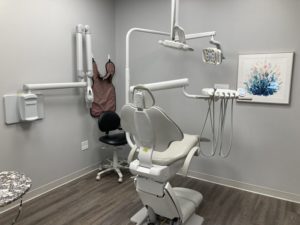
Press Release MetroHealth Opens Ohio City Family Dental Clinic
MetroHealth on Thursday opened its family dental clinic in Cleveland’s Ohio City neighborhood, capping off a years-long transformation of a site where residents once fought to block the construction of a McDonald’s.
Signet Real Estate Group served as the Developer and Owner’s Representative in the delivery of this project.
The Ohio City Family Dentistry, located at the corner of Lorain Avenue and Fulton Road, will serve both adult and pediatric patients. It offers everything from routine check-ups and cleanings to root canals, bridges, partial dentures, and crowns. It also has on-site dental imaging, such as X-rays.
MetroHealth previously offered dental services at its main campus. The health system closed its main campus dental clinic last week after more than 60 years and is relocating all of its dental services to the Ohio City location.
The Ohio City clinic has the advantage of having more of a neighborhood feel, MetroHealth President and CEO Dr. Akram Bourtos said. It doesn’t require patients to travel to the main campus for a routine check-up or cleaning, and it’s accessible by bus on the RTA’s Lorain Avenue (22) and Fulton Road (79/79A) routes.
“The idea about this building is very simple,” Boutros said during a ribbon-cutting ceremony Wednesday afternoon. “We need to go where our patients are, and we need to be in a much more accessible environment to them.”
The new clinic is also a boon to MetroHealth’s dental employees, who will have the opportunity to work with some of the latest technology available, said Dr. Gregory Heintschel, the chair of the health system’s department of dental medicine.
Lasers will replace traditional dental drills for many procedures, including drilling a cavity. The clinic is also outfitted with a dental microscope, which will help staff who are performing root canals or cosmetic procedures, Heintschel said.
The clinic also has 3D printers that will be used to make custom dental appliances, crowns, and restorations on the same day of a patient’s appointment. That will eliminate the need for any follow-up appointments.
Each dental chair is also supplied with nitrous oxide. The mild sedative, which is commonly referred to as “laughing gas,” is a safe method for managing a patient’s pain and anxiety, according to the American Dental Association. It should help a patient relax and lessen discomfort when they come to the dental clinic, Heintschel said.
The next generation of dentists will also benefit from the new clinic. MetroHealth’s General Practice Dentistry Residency program is also moving there from the main campus. In addition, two pediatric residents will be working at the clinic as part of a partnership with Case Western Reserve University’s School of Dental Medicine.
Heintschel also feels the dental clinic will benefit the Ohio City neighborhood and its residents. The clinic brings dental services to a neighborhood that did not previously have easy access to them, he said.
“It’s a way to give back to this community – typically an underprivileged community – which really has not had a lot of great places to go, historically, for their care,” Heintschel said. “Now they’ve got a truly exceptional place, with exceptional people to care for them.”
Those residents were heavily invested in the fate of the property where the dental clinic now sits. It used to be home to a Hollywood Video, but it sat dormant for more than a decade after that store closed. Investors subsequently bought the property and intended to turn it into a McDonald’s.
The proposal led to fierce opposition from the neighborhood. The opposition led to a court battle, and the McDonald’s deal quietly expired. MetroHealth then bought the property for about $1.17 million in 2016.
Cleveland City Council member Kerry McCormack, whose Ward 3 includes the neighborhood, said during Wednesday’s ribbon-cutting that Ohio City residents’ activism helped make the dental clinic a reality.
“This would not have happened were it not for the years and years of advocacy by our neighborhood residents,” McCormack said.
Read the original article here.
